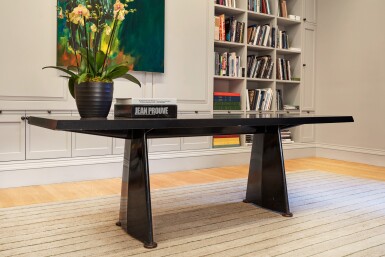
Jean Prouvé
"Centrale (Trapèze)" Table, Petit Modèle
Auction Closed
December 8, 05:46 PM GMT
Estimate
700,000 - 1,000,000 USD
Lot Details
Description
Jean Prouvé
"Centrale (Trapèze)" Table, Petit Modèle
designed circa 1951-1952, produced circa 1956
produced by Ateliers Jean Prouvé, Nancy, France
lacquered bent sheet steel, okoume plywood
28⅝ x 87½ x 28⅜ in. (72.6 x 222.2 x 72 cm)
Galerie Jousse-Seguin, 1996
Jean Prouvé, exh. cat., Galeries Jousse-Seguin et Navarra, Paris, 1998, p. 88
Peter Sulzer, Jean Prouvé: Œuvre Complète, Volume 2: 1934-1944, Basel, 2001, fig. 545.2.1
Peter Sulzer, Jean Prouvé: Œuvre Complète, Volume 3: 1944-1954, Basel, 2005, fig. 1163.8
Jacques Barsac, Charlotte Perriand: Un Art d'Habiter, Paris, 2005, p. 492
Catherine Dumont d'Ayot, ed., Jean Prouvé: The Poetics of the Technical Object, 2007, p. 313
Galerie Patrick Seguin and Sonnabend Gallery, ed., Jean Prouvé, Vol. I, Paris, 2007, pp. 424-427
Galerie Patrick Seguin and Sonnabend Gallery, ed., Jean Prouvé, Vol. II, Paris, 2007, pp. 57, 66-67 and 76-77
Peter Sulzer, Jean Prouvé: Œuvre Complète, Volume 4: 1954-1984, Basel, 2008
Jean Prouvé first came up with the concept for the trapezoidal bent steel base in the 1930s in his exploration of designs for lecture-hall chairs. He then adapted the concept in late 1949 at the request of Charlotte Perriand for a reading table to be included in the Maison de l’Etudiant in Paris. Shortly afterwards, Prouvé designed yet another new variant called the “Centrale” table, of which the present lot is a prime example, to be used as a conference room and lecture hall table. The “Trapèze" table includes bent steel legs with inverted cup feet held together by an inset beam to which are attached support brackets for the top—for large tabletops of 350 cm or larger, an extra leg or one or two additional support brackets were usually added. The metal parts are oven-lacquered and the top, most often rectangular, is made with lacquered wood. The present model was marketed for public offices and conference rooms from 1952 onwards and used for the common areas of Antony’s Cité Universitaire in 1956. A few variations were made, including examples with an overhead lighting installation, solid wood tabletops and a curved tabletop surface. The “Centrale” table embodies the essence of Prouvé’s incomparable sense of style and ingenious use of metal to create timeless and functional pieces of furniture, exhibiting his mastery of proportion, line and purity of form.
